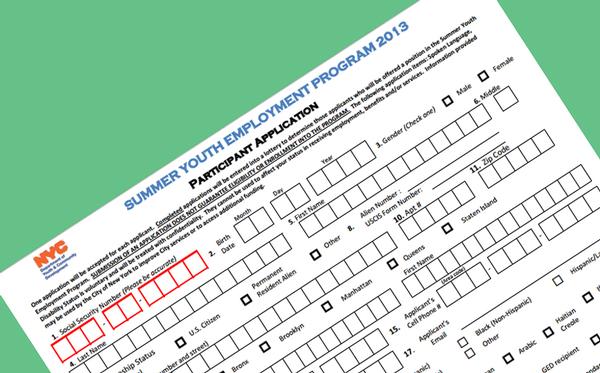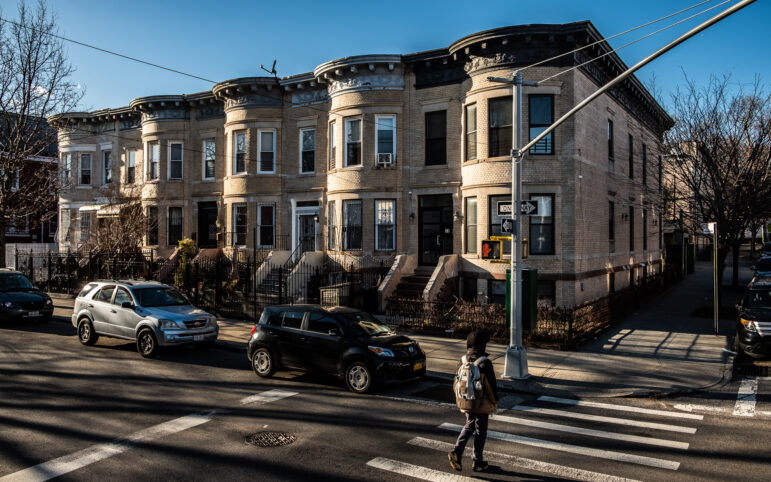
Photo by: DYCD/J. Murphy
Isaiah Phillip, a Brooklyn youth who has been looking for work for a few years, is worried. “In certain times you’re going to wonder, ‘If I can’t get this job how am I going to support myself when it’s time…to leave the house?’ I’m already predicting a future that isn’t going to end well. And that scares me.”
“If I can’t have a job to support or help myself or my family then I’m thinking that it’s going to end in a result where we are homeless or there’s going to be choices that shouldn’t be made and we could regret,” explained Philip to researchers at Families United for Racial and Economic Equality (FUREE), a low-income advocacy organization.
Isaiah, like many of Brooklyn’s young people, worries about the 19 percent unemployment rate among people ages 16 to 21 in New York City—the highest among any age group in the area. The rate of unemployment increases to 26 percent for youth of color.
Earlier this month, FUREEous Youth—a youth-led, grassroots organization that emphasizes power through employment in downtown Brooklyn—partnered with The Community Development Project (CDP) at the Urban Justice Center to highlight the failure of government programs to meet the employment needs of New York’s young people. In particular, budget cuts to programs such as the Summer Youth Employment Program (SYEP), which provides teens with summer jobs, has forced the program to limit its slots and therefore turn away ready and willing youth.
In the final budget deal approved June 25 by the mayor and City Council, SYEP remained stable for the 2014 fiscal year. However, even without further cuts, previous decreases in funding in beginning in 2009 have led to setbacks in programming. While in previous years the program ran seven weeks, in 2013 it will only run for six. “For some of these kids, SYEP is the only work experience they are going to get, so six weeks just doesn’t yield enough experience or a substantial paycheck ,” says FUREEous Youth’s Desiree Marshall.
Viewed as valuable
While other summer employment programs exist, SYEP ranks highly among teens across the city and is sought after because it combines skill training and pay. According a survey by the Department of Youth and Community Development, 75 percent of young people who were able to participate in SYEP reported that they would have been unable to find work without the program’s assistance.
Out of School Time after-school summer programming—which offers snacks, tutoring and recreational activities such as chess, dance, sports and music—is only available to students currently enrolled in grades K-12 and between the ages of 5 and 18. The thousands of young people who do not fit this criterion but desire productive summer programming look to summer employment programming, usually in the form of SYEP.
“This program fills a void,” says Marshall. “While after school programs focusing on things like art and dance are important, these career-based programs are stepping stones for these young people to feel better equipped to survive in today’s economy and move forward with their lives.”
SYEP is run by the Department of Youth and Community Development (DYCD), which spent $45.2 million in 2012 to operate the program. Much of this money goes to salaries for the participants—many of whom rely on this money to help their families with bills or other expenses. In addition to pay, youth participating in the SYEP program also value the program for the practical skills taught during its job training courses, including how to balance a checkbook and format a résumé.
“These young people are not just working for extra dollars in their pockets—it’s not just about keeping busy during the summer but survival. This is usually their first job and gives them their best chance at obtaining other ones in the future,” explains Marshall. “The majority of them have a very hard time finding work without such programming.”
A special vulnerable youth category is also eligible to participate in SYEP. Like the other participants, those who are homeless, runaway and aging out of foster care apply to work a 25-hour week at entry-level jobs. For these high-needs youth, this possibility for employment represents one of their best chances at entering the job market.
Eric Valentin Jr., a 21-year-old FUREEous Youth leader, was not accepted for SYEP this past year. In a statement released by FUREEous Youth he said, “My family was behind on rent, bills were overdue, and we were about to lose our apartment. The income from SYEP was going to help my family, so when I was rejected I felt like a zombie. I felt defeated…I had no clue there were only a few spots available for the thousands of kids that applied. All I could think about was, ‘How am I going to help my mom without a job?’”
Past cuts still sting
Even with no drop in funding, SYEP is still being adjusted this year to try and do more with less. Educational portions of the program are now being cut down and students are not paid to attend. Additionally, the program is splitting up participants into age groups, which may affect their ability to get hired as some employers don’t like accepting large numbers of younger workers.
Meanwhile, other opportunities for young workers are shrinking. The New York Youth Works (NYYW) program, another promising opportunity for summertime youth employment, offered 2,900 positions for disadvantaged youth during the summer of 2012. This summer it has accepted zero applicants.
In 2011, Governor Andrew M. Cuomo signed NYYW into law, and $33 million was allocated to the program, which gave tax credits to businesses hiring disadvantaged youth. To qualify for the program, participants had to either receive public assistance, live in public housing or receive housing assistance, be a veteran, be pregnant or parenting, be homeless, be in the foster care system, have served time in jail or prison or be on probation or parole. While NYYW successfully gave nearly 3,000 young people jobs who typically had trouble finding quality work, it was only set up to be a one-year program and was subsequently terminated.
“You have so many young people who are willing and want to work but can’t. They might spend the summer bored and sitting at home or perhaps be involved in community organizations but they won’t be furthering their own employment opportunities in the same meaningful way,” explains Marshall. “They just want valuable ways to spend their summers.”
Room for improvement
At a press conference at the steps of City Hall on June 5th, the youth leaders of FUREEous Youth’s new No Money, Mo’ Problems Campaign presented several recommendations on improving employment opportunities for fellow city youth. The suggestions, such as increasing the number of slots and the length of summer jobs programs, were gleaned from over 300 surveys and a focus group of young adults conducted by FUREEous Youth members and CDP employees.
According to participants, the current amount of funding SYEP receives does not yield a perfect program. SYEP has been criticized by the youth it services for not catering to their needs and career interests. Young people in a FUREE-run focus group also said that it was hard to learn how to build a résumé and hear personal finance tips when crowded into a huge gym with a single instructor instead of one-on-one interactions.
“I think it was irrelevant too because all we did was pack up the papers—and place the papers in the printer and check if the bathroom has tissue and that’s pretty much it. That’s all we did.” Others wished that the program could have been longer, as working for only six weeks at minimum wage left many unable to substantially improve their economic situation.
However, DYCD has reported that 98 percent of its 2012 participants rated the program as either ‘excellent’ or ‘good.” One SYEP 2012 participants stated that “I would definitely recommend SYEP, it’s a good program overall…Definitely, time management, responsibility, money control, self evaluations. That’s what it does for you so it’s a great program…”
Wage changes have impact
The future of summer employment programming is uncertain. The impact of the state legislature’s increasing the minimum wage to $8.00 per hour in 2014 will undoubtedly impact programming like SYEP by increasing its operational costs.
However, young people and their advocates remain hopeful that the large turnover in City Council this year, the possibility for four new borough presidents and a new mayor will translate into a big change in funding priorities.
“We are ready for new opportunities,” said Marshall. “The money we need is there and we have made it clear to those coming into City Council why we need it.”








